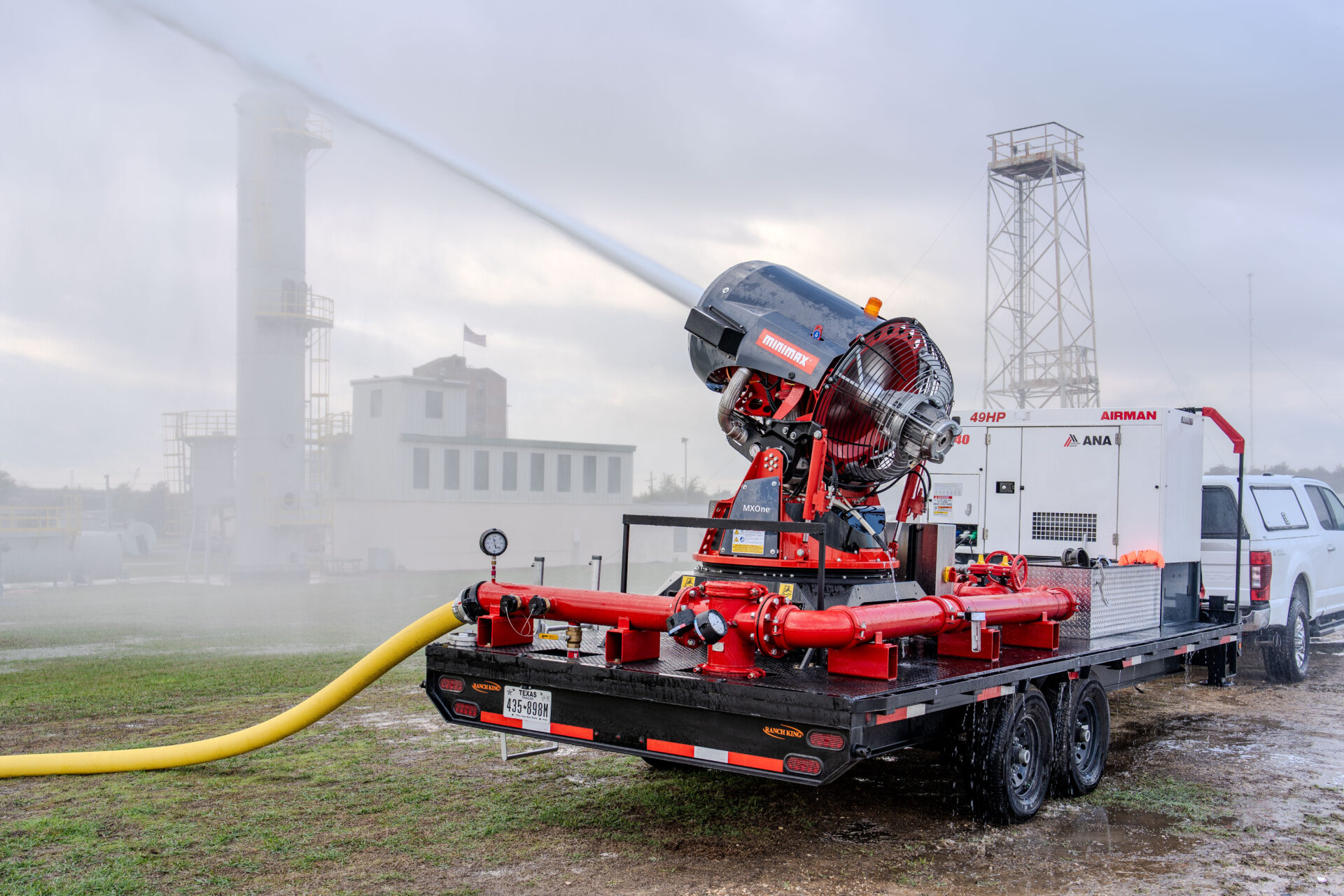Government Agencies
Challenges
High Value Asset Protection
Expansive Confined Spaces
Complex Fire Scenarios
Protection Without Harm
The MXOne addresses all the most common challenges of Governmental Agency supported firefighting. Expansive space and variable conditions are met with extended range options and a variety of application methods to meet your specific scenario. The MXOne supports foam application and water mist to suppress and extinguish even the most challenging fire situations with the firewater medium of your choice. The water mist mode also offers incredible encapsulating properties for the smoke, particulates and debris associated with governmental agency fires. You control the power, distance and spray pattern, all while remaining at a safe distance to mitigate any additional damage in addition to the initial ignition.
Automated detection and deployment for safe and timely fire suppression.
Flexible deployment strategies and industry best performance allow the MXOne to be an essential part of any fire suppression system, especially when protecting critical equipment and structures in remote locations.
During a fire, water mist mode suppresses smoke spread, particulate dispersal and reduces vapor escape while effectively extinguishing deep seeded fires. . It also is excellent for pre-fire wetting and application of all wetting agents. The high-volume turbine fan can be used to clear smoke and enhance visibility after a fire.
The MXOne can be the foundation for the replacement of overhead protection without the need for re-piping and costly downtime.
Extended reach and remote operations capabilities allow your firefighters to effectively engage the objective while remaining at a safe distance.
The MXOne has the capability to utilize fresh and/or saltwater as a primary extinguishing medium with the ability to deliver any water additives including foam, encapsulants and wetting agents.
Specifications
Next-generation fire protection
The Minimax MXOne high-performance extinguishing turbine represents a new generation of fire fighting. Through an electrically adjustable jet pipe, the turbine achieves wide coverage, even with the addition of foam concentrate. The integrated position sensors provide the intelligent control system with continuous feedback on the setting mode and alignment of the extinguishing turbine.
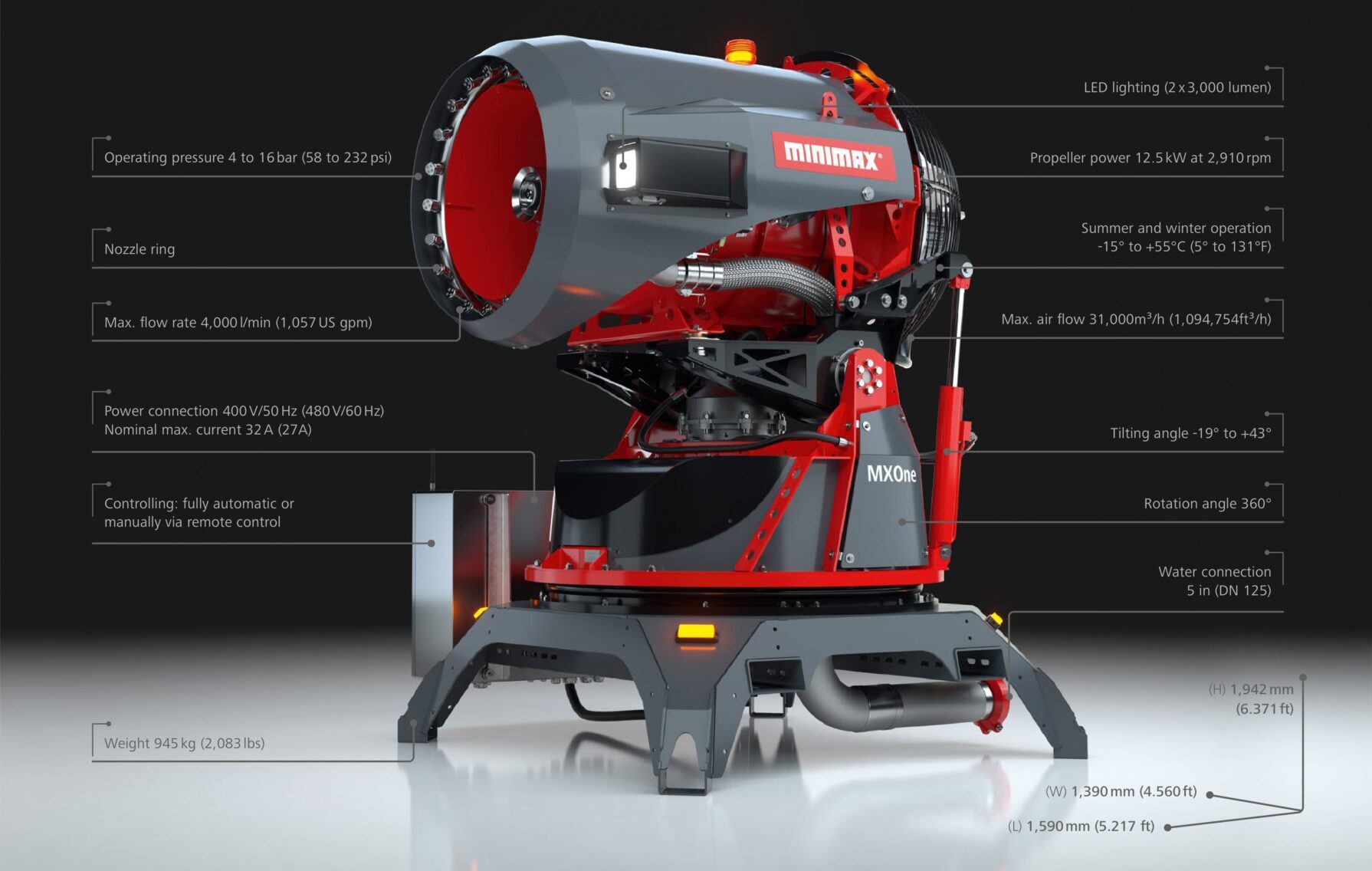
The water mist it generates absorbs large amounts of energy in the event of a fire, providing effective cooling and, due to its three-dimensional operation, can also reach hidden sources of fire. It also binds smoke gases, pollutants, and odors and can quickly take effect over large areas. Unlike classic monitors that use a focused jet, the turbine’s gentle application of water prevents burning material from being dispersed and potentially causing additional fire spread. MXOne is unprecedented in its ability to protect urban/ wildlife interface areas, prioritizing both resedential areas and natural habitats.
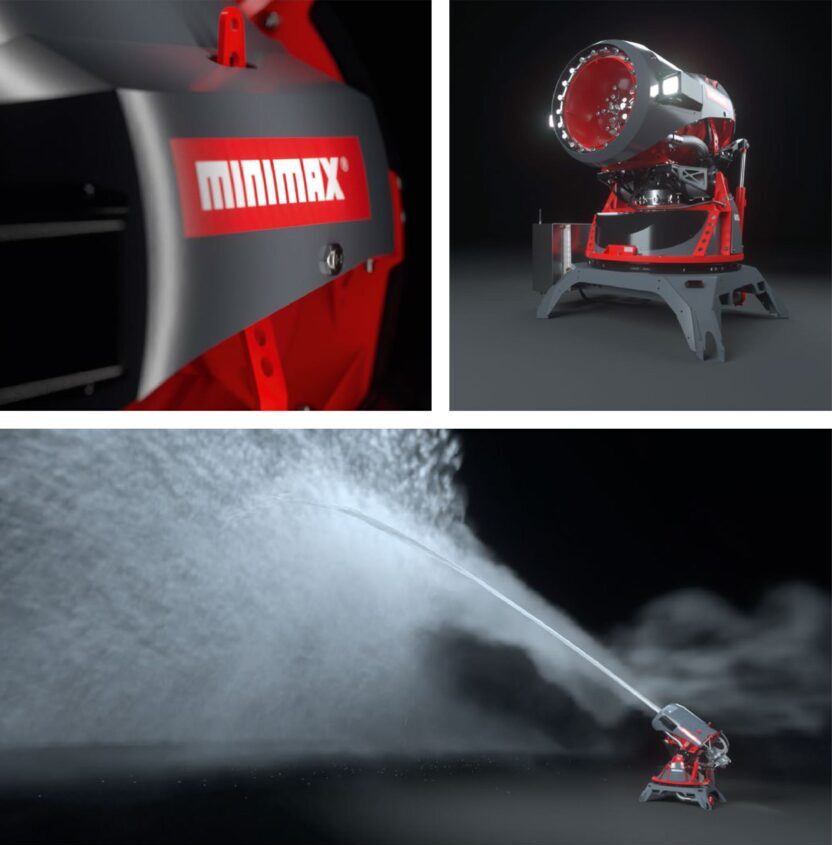
With MXOne, a wide range of fire scenarios can be safelymastered. The flexible applicability of different extinguishing media plays a key role. MXOne can be operated with townwater, salt water, with and without foam concentrate admixtures (also fluorine-free).
Due to its advantageous operating parameters, the extinguishing turbine is easy to integrate into existing systems and is suitable for use in areas with temperatures ranging from -15 to +55 °C.
MXOne is – depending on the configuration – either fully automatically or remotely and manually aligned to a hot spot. Thanks to intelligent control, even two or more neighboring areas can be alternately supplied with extinguishing water using a single turbine in automatic mode. This allows several fires to be fought in parallel or nearby facilities threatened by fire to be cooled in a targeted manner.
Due to a highly hydraulically balanced and optimized design, the MXOne impresses with relatively large coverage at already low water pressure, thereby requiring less extinguishing water compared to conventional monitors or similar machines.
Variants:
- Stationary on the ground
- Stationary on tower (high pile)
- Mobile on trailer (trailer)
- Mobile on flat rack container with own power and water supply
Spray patterns and extinguishing media
Fighting fire with water mist from a long distance is one of the MXOne’s unique strengths. The turbine compensates for the susceptibility of small drops to external influencing factors, like crosswinds or headwinds, by intelligently controlling and switching on the propeller. In addition, the system can be flexibly adapted to almost any challenge from different fire scenarios. MXOne achieves unprecedented versatility of use, as it can be used with town water as well as with salt water or foam concentrate (also fluorine-free), and the extinguishing agent can then be applied in a variety of spray patterns – from fine water mist to full jet.
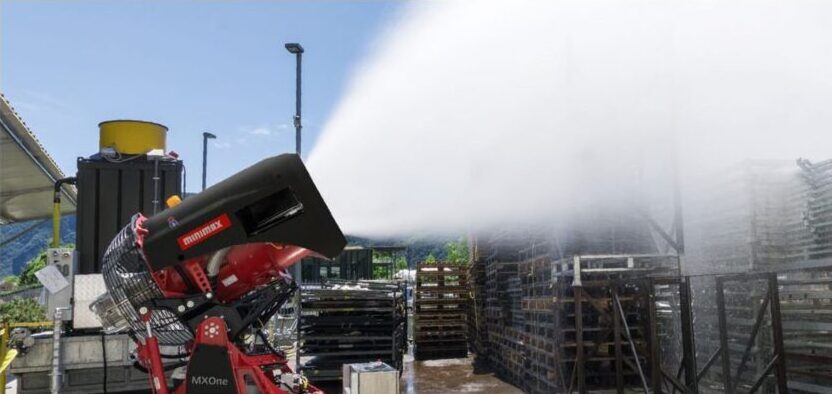
Extinguishing with water mist:
Minimum water use, maximum effectiveness
When extinguishing with water mist, water is atomized under high pressure to create tiny water droplets, and thus a larger reaction surface for absorbing heat. When the water droplets evaporate completely near the flame, their volume is increased by a factor of 1600, so that the oxygen at the source of the fire is temporarily displaced and the resulting smothering effect abruptly suppresses the fire. The downstream water mist creates a highly effective cooling effect, ensuring that the backfire temperature is undercut as quickly as possible and the fire is extinguished. In addition, the water mist protects people and property from the effects of heat. The amount of water used in an extinguishing attack with water mist is considerably less than with full-jet extinguishing, so significantly less water damage can be expected.
- Water has a very high specific heat capacity (~ 4.2 kJ/(kg-K)), meaning it can absorb large amounts of energy compared to other liquids and solids.
- The smaller the water droplets are when dispersed, the larger their surface area and the faster their heating and evaporation occur (energy extraction from the fire). With evaporation, additional inertization takes place through oxygen displacement.
- The total surface area of a water droplet is inversely proportional to its diameter.
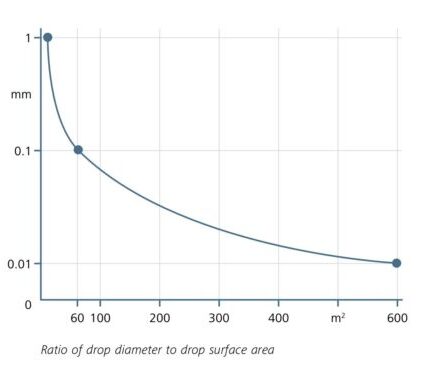
- 1l of water sprayed in a drop size of
– 1mm diameter = 6m2
– 0.1mm diameter = 60m2
– 0.01mm diameter = 600m2 - Due to the properties of water mist, effective fire fighting can be realized even with minimal water use.
- The droplet spectrum must be optimally selected so that the fire source can also be reached against the fire thermals.
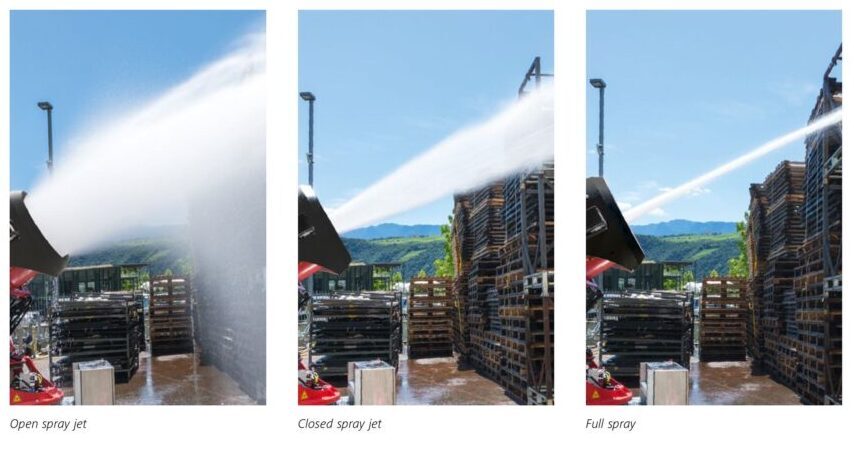

Comprehensive efficacy tests passed
The MXOne has proven its reliability in numerous efficacy tests under the supervision of the independent test and inspection institutes, DMT and FlameCert, respectively. Minimax engineers have tested the system in full-scale fire tests (with combustible liquids, kerosene, plastic waste, and wood) and optimized it for use in the various application areas. Minimax expertise in engineering, installation, and service ensures that with MXOne, customers receive a system that sets new standards in supporting fire protection.
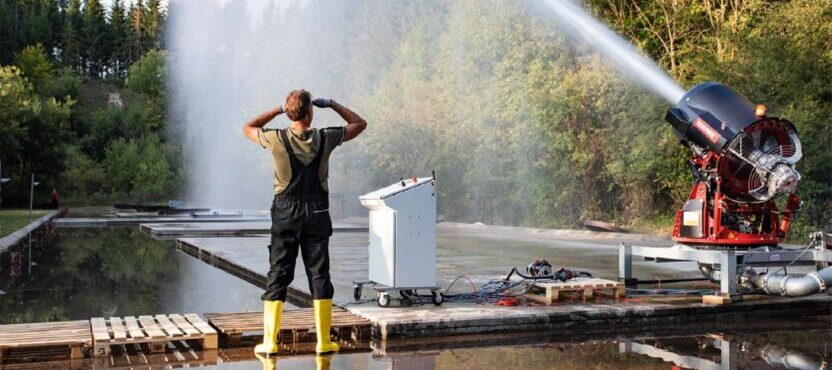
Field tests and sales release
The development of an extinguishing system includes, among other things, successfully passing fire tests with a variety of representative combustible materials, which have been confirmed by independent bodies. Minimax engineers have also repeatedly tested the MXOne under a variety of weather conditions, and are continuously incorporating practical experience into the further development of the system. In this way, it has already been possible to make improvements like significantly increasing coverage distances and optimizing the spray patterns for use in various fire scenarios.

Solid fires
Depending on the distance, weather factors, and fire thermals, solid fires can be reliably extinguished with water mist or adapted spray. The selection of the spray pattern has a crucial effect on the coverage and penetration ability of the extinguishing agent. Spray obstructions must also be taken into account when determining the spray pattern, for optimal control of a fire on an objecthat can form embers.
Example of an experimental setup
Burning material: Stack of wooden pallets
Distance: 60m
Extinguishing agent: Water
Plastic waste fires
Plastic waste poses a high fire risk, especially in recycling facilities and waste processing plants. Because the exact composition of the waste is not known to the storage company, it can repeatedly catch fire through spontaneous combustion. Thermoplastic, thermosetting, of foam plastics, together with their additives, emit toxic gases in the event of a fire. For this reason, foam-based extinguishing agents are often the better choice. The foam settles on the burning material, extinguishes the fire, and prevents against re-ignition and fire spread.
Example of an experimental setup
Burning material: Recyclable material bags with contents
Distance: 55m
Extinguishing agent: Fluorine-free foaming concentrate
Liquid fires
Liquid fires are also fought with foam concentrate. Key for a fast, successful extinguishing attack is the gentle application and even distribution of the extinguishing agent. The foam needs to spread completely over the surface without any burning liquid escaping from the test pan. The foam cover prevents re-ignition.
Example of an experimental setup
Burning material: Non-polar fabric in FM fire pan
Distance: 50m
Extinguishing agent: Fluorine-free foaming concentrate
Kerosene liquid fires
Due to its low flash point, spilled and ignited kerosene poses one of the most dangerous situations when fight ing fires at airports and in hangars. Because it spreads in three dimensions, it runs the risk of explosion due to the rising gases. Here, too, the film-forming property of foam extinguishing agents and their sticking effect are necessary.
Example of an experimental setup
Burning material: Kerosene in FM fire pan
Distance: 75m
Extinguishing agent: Fluorine-free foaming concentrate MX ad One 3/3 f-0


